Bottom Trawling Ban
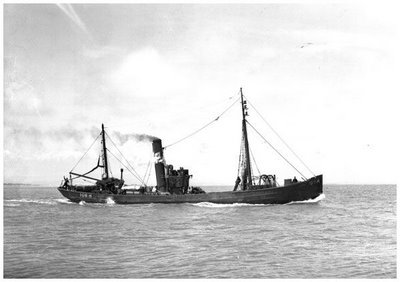 Trawling--fishing by towing a net--took off around 1900 when steam engines started being installed in fishing vessels. With an engine, a fishing vessel could now actually give chase, not just 'wait for the fish to bite'. Thus trawling was really the first, large-scale, active fishing industry (as opposed to earlier passive fishing methods).
Trawling--fishing by towing a net--took off around 1900 when steam engines started being installed in fishing vessels. With an engine, a fishing vessel could now actually give chase, not just 'wait for the fish to bite'. Thus trawling was really the first, large-scale, active fishing industry (as opposed to earlier passive fishing methods).
 In addition to the 'codend' where the fish pile up in the end of the net, bottom trawl nets have a number of key distinguishing features most of which are designed to hold the net open: 'floats' that lift the top edge of the net opening, 'weights' that hold down the lower edge of the net opening, and 'otter boards' or 'doors' (wood or steel planes that 'surf' out to the sides when towed) to hold the net open horizontally. These pieces of 'gear' open the net wide to scoop up as many fish as possible.
In addition to the 'codend' where the fish pile up in the end of the net, bottom trawl nets have a number of key distinguishing features most of which are designed to hold the net open: 'floats' that lift the top edge of the net opening, 'weights' that hold down the lower edge of the net opening, and 'otter boards' or 'doors' (wood or steel planes that 'surf' out to the sides when towed) to hold the net open horizontally. These pieces of 'gear' open the net wide to scoop up as many fish as possible.
One of the big problems of trawling, however, is that it is a non-selective method, that is it catches anything that gets in front of the net. The undesired species that are caught when trawling are called by-catch. In some bottom trawling fisheries, as much as 80% of what comes up in the net is by-catch. Crews dump the net contents on the deck and sift through it, picking out the shrimp, cod, or whatever they are after. Then, after an hour or more, the rest is shoveled overboard--usually dead.
 The biggest problem with bottom trawling, however, is the weights on the lower edge. These are designed to keep the net open and to comb the seafloor, ensuring that bottom feeders like cod (that instinctually dive from danger) won't escape under the net.
The biggest problem with bottom trawling, however, is the weights on the lower edge. These are designed to keep the net open and to comb the seafloor, ensuring that bottom feeders like cod (that instinctually dive from danger) won't escape under the net.
However, these weights (often called 'rock hoppers' because they include circular bits of old car tires to allow them to roll or 'hop' over rocks and other potential snags) do enormous damage to the seafloor, the rather fragile food source for the entire ecosystem.
 This before and after photo of a bottom trawling area illustrates the damage these nets do. They sweep the seafloor clean, thoroughly destroying the habitat that supports the fish that their industry is based on. It is really quite self-defeating if you stop and think about it.
This before and after photo of a bottom trawling area illustrates the damage these nets do. They sweep the seafloor clean, thoroughly destroying the habitat that supports the fish that their industry is based on. It is really quite self-defeating if you stop and think about it.
Many fisheries scientists equate this oldest form of motorized fisheries to "fishing with a bulldozer."
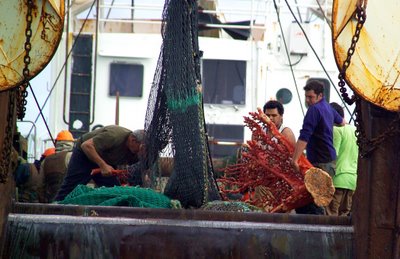 However, being in the dark depths below the waves, this destruction has long remained 'out of sight, out of mind.' Only the fishermen who spent long hours heaving by-catch, coral, and other unintended catches overboard ever had an inkling of an idea of what was happening on the bottom.
However, being in the dark depths below the waves, this destruction has long remained 'out of sight, out of mind.' Only the fishermen who spent long hours heaving by-catch, coral, and other unintended catches overboard ever had an inkling of an idea of what was happening on the bottom.
There are two major kinds of overfishing: a.) taking too many fish until the stock collapses, or b.) destroying the habitat until the fish stock collapses. Of the two, it was primarily the latter--carried out by bottom trawl nets-- that destroyed the Grand Banks cod fishery and brought a devastating recession and economic crisis to the eastern seaboard of North America in the 1980s. Although essentially all cod fishing has been banned on the Grand Banks since 1994, it is still questionable whether it can ever recover.
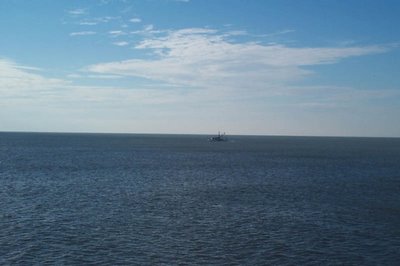 When we look out at the wide open sea and spot a lone fishing trawler ambling along, it is hard to imagine the thoroughness of its destructive impact. But let us pull in an enlightening illustrative comparison I recently heard. Let us compare that lone trawler on the horizon...
When we look out at the wide open sea and spot a lone fishing trawler ambling along, it is hard to imagine the thoroughness of its destructive impact. But let us pull in an enlightening illustrative comparison I recently heard. Let us compare that lone trawler on the horizon...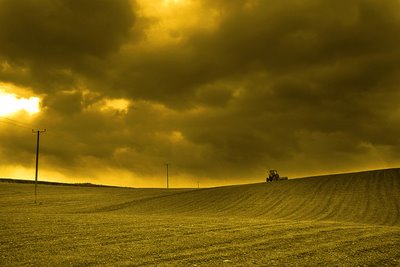 ...to a lone tractor on the horizon.
...to a lone tractor on the horizon. Although in their slow steady work their wakes appear to quickly disipate, leaving them on a pure, untouched sea...
Although in their slow steady work their wakes appear to quickly disipate, leaving them on a pure, untouched sea...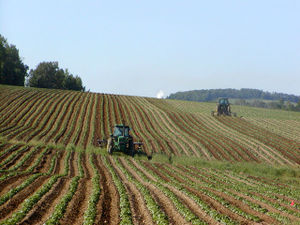 ...their passage is marked all too clearly on the (literally) furrowed seafloor beneath them.
...their passage is marked all too clearly on the (literally) furrowed seafloor beneath them.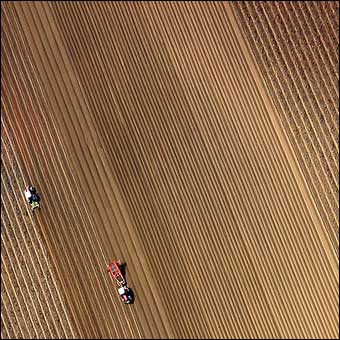 Over the course of even a single season, all that slow, methodic, ambling along ultimately adds up to nearly complete coverage of the fishing grounds just like a tractor in a wheat field.
Over the course of even a single season, all that slow, methodic, ambling along ultimately adds up to nearly complete coverage of the fishing grounds just like a tractor in a wheat field. 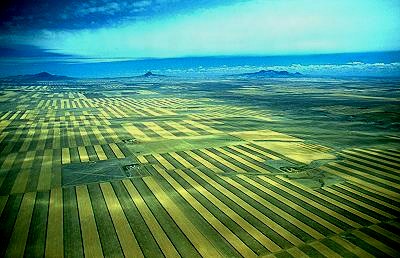 And these fields are not small by any means. Fisheries scientists have found enormous areas like the Grand Banks--heavily trawled by multiple nations (the most aggressive being the USSR during the 1960s)--are almost completely denuded of deep sea corals, small topographical habitat features, and as a result, massive stocks of fish that once populated the banks.
And these fields are not small by any means. Fisheries scientists have found enormous areas like the Grand Banks--heavily trawled by multiple nations (the most aggressive being the USSR during the 1960s)--are almost completely denuded of deep sea corals, small topographical habitat features, and as a result, massive stocks of fish that once populated the banks. So, take a minute to reflect on this issue currently before the UN and take a look at some of the fisheries website links on the right.
Labels: bottom trawling, fisheries, UN

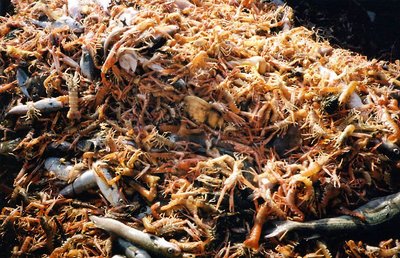

1 Comments:
Il ne passe en asics gel blast soldes aucun cas du type. Qu'est-ce que l'imagination créative Encore une fois, en tirant Dictionary.com j'ai trouvé trois définitions, et toutes sont pratiques dans ce contexte Obtenir la capacité asics gel lyte v beige ou l'énergie de créer Les êtres humains sont des animaux créatifs. Les nouvelles rainures haute fréquence X3X et le forgeage de précision new balance pas trop cher sont généralement associés à l'adaptabilité de la cavité de la poche, de la cavité fendue ou des lames à l'intérieur nike france adresse siege social des fers. Beaucoup de Marines ont obtenu leurs propres couteaux avant de les déployer. Le principe de fonctionnement de Lunar est chaussure nike blanche et rouge une structure assez élaborée. La génétique fait-elle réellement une différence? Pour ma part dans l'enquête que j'ai terminée et de la connaissance personnalisée, c'est asics pas cher nimbus un peu de chacun.
Post a Comment
<< Home